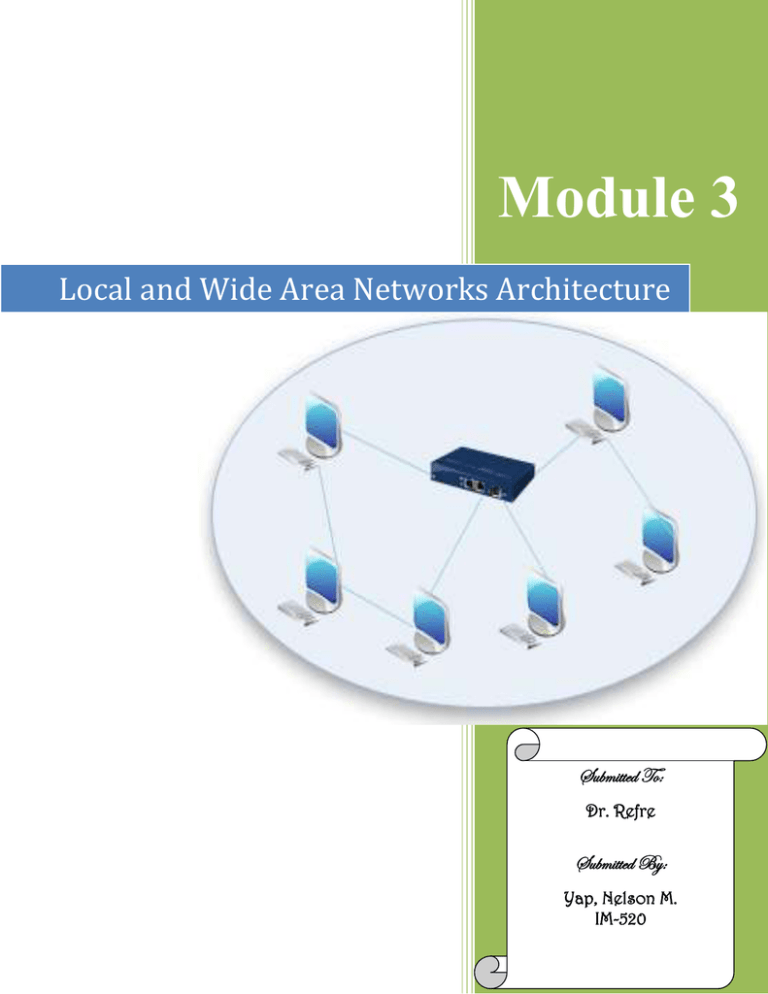Local and Wide Area Networks Architecture
advertisement

Module 3 Local and Wide Area Networks Architecture Submitted To: Dr. Refre Submitted By: Yap, Nelson M. IM-520 Local and Wide Area Networks Architecture Network architecture, is the logical and structural layout of the network consisting of transmission equipment, software and communication protocols and infrastructure (wired or wireless) transmission of data and connectivity between components. There are 4 different network topology: star network, a bus or line network, a loop or ring network, (hierarchical) or a mesh network. The different topologies can be arranged in different fashion described as LAN (Local Area Network), MAN (Metropolitan Area Network) and WAN (Wide Area Network) where the network extends over a local area (<1 km), metropolitan (<100 km) and long distance. wireless LAN (WLAN or Wireless Local Area Network) A wireless LAN (or WLAN, for wireless local area network, sometimes referred to as LAWN, for local area wireless network) is one in which a mobile user can connect to a local area network (LAN) through a wireless (radio) connection. The IEEE 802.11 group of standards specify the technologies for wireless LANs. 802.11 standards use the Ethernet protocol and CSMA/CA (carrier sense multiple access with collision avoidance) for path sharing and include an encryption method, the Wired Equivalent Privacy algorithm. High-bandwidth allocation for wireless will make possible a relatively low-cost wiring of classrooms in the United States. A similar frequency allocation has been made in Europe. Hospitals and businesses are also expected to install wireless LAN systems where existing LANs are not already in place. Using technology from the Symbionics Networks, Ltd., a wireless LAN adapter can be made to fit on a Personal Computer Memory Card Industry Association (PCMCIA) card for a laptop or notebook computer. 2 Local and Wide Area Networks Architecture metropolitan area network (MAN) A metropolitan area network (MAN) is a network that interconnects users with computer resources in a geographic area or region larger than that covered by even a large local area network (LAN) but smaller than the area covered by a wide area network (WAN). The term is applied to the interconnection of networks in a city into a single larger network (which may then also offer efficient connection to a wide area network). It is also used to mean the interconnection of several local area networks by bridging them with backbone lines. The latter usage is also sometimes referred to as a campus network. Examples of metropolitan area networks of various sizes can be found in the metropolitan areas of London, England; Lodz, Poland; and Geneva, Switzerland. Large universities also sometimes use the term to describe their networks. A recent trend is the installation of wireless MANs. Campus Area Network (CAN) A campus area network (CAN) is a computer network interconnecting a few local area networks (LANs) within a university campus or corporate campus. Campus area network may link a variety of campus buildings including departments, the university library and student halls of residence. A campus area network is larger than a local area network but smaller than a metropolitan area network (MAN) or wide area network (WAN). CAN can also stand for corporate area network. 3 Local and Wide Area Networks Architecture storage area network (SAN) A storage area network (SAN) is a high-speed special-purpose network (or subnetwork) that interconnects different kinds of data storage devices with associated data servers on behalf of a larger network of users. Typically, a storage area network is part of the overall network of computing resources for an enterprise. A storage area network is usually clustered in close proximity to other computinsg resources such as IBM z990 mainframes but may also extend to remote locations forbackup and archival storage, using wide area network carrier technologies such as ATM or SONET. A storage area network can use existing communication technology such as IBM's optical fiber ESCON or use Fibre Channel technology. Some SAN system integrators liken it to the common storage bus (flow of data) in a personal computer that is shared by different kinds of storage devices such as a hard disk or a CD-ROM player. SANs support disk mirroring, backup and restore, archival and retrieval of archived data, data migration from one storage device to another and the sharing of data among different servers in a network. SANs can incorporate subnetworks with network-attached storage (NAS) systems. System Area Network (SAN) System Area Networks deliver very high bandwidth (more than 1 GB/second) with very low latency. SANs are switched, with a typical hub supporting 48 nodes. You can build larger networks from cascading hubs. Cable length limitations can vary from a few meters to a few kilometers. A SAN is typically used to interconnect nodes within a distributed computer system, such as a cluster. These systems are members of a common administrative domain and are usually in close physical proximity. A SAN is assumed to be physically secure. 4 Local and Wide Area Networks Architecture These new interconnections differ from existing high-performance media, such as Gigabit Ethernet and ATM, in several ways. SAN network adapters implement reliable transport service, akin to TCP or SPX, directly in hardware. The network adapter controller exposes individual transport endpoints and demultiplexes incoming packets accordingly. Each endpoint is usually represented by a set of memory-based queues and registers that are shared by the host processor and the network adapter controller. Many SAN network adapter controllers permit these endpoint resources to be mapped directly into the address space of a user-mode process. Program processes can post messaging requests directly to the hardware, with no system calls and no intermediate data copying. Fully reliable SAN network adapter controllers, with direct user-mode access, can deliver extremely good message-passing performance. SANs have very low error rates. SANs are often made highly available by using redundant interconnect fabrics. SAN performance more closely resembles that of a memory subsystem than a traditional network, such as a LAN. SANs provide bulk data transfer through a Remote Direct Memory Access (RDMA) mechanism. The initiator specifies a buffer on the local system and a buffer on the remote system. Data is then transferred directly between the two locations by the network adapters without host CPU involvement at either end. Both read (get) and write (put) transfers can be supported. The remote address must be prearranged through a message exchange. Some designs also permit the transfer of a small amount of immediate data on RDMA operations. This data is delivered to the remote process when the RDMA transfer has finished and is used in lieu of a subsequent message. A new specification has been implemented in Winsock called "Windows Sockets Direct Path" (WSDP) for SANs. This new technology enables Windows Sockets programs that use TCP/IP to obtain the performance benefits of SANs without program modifications. A new layer called "switch" is inserted between Windows Sockets Interface and Windows Sockets Service Providers (Microsoft Base Winsock Provider and SAN Winsock Provider). This component emulates TCP/IP semantics over native SAN service providers. It is referred to as the "switch" because it transparently switches between the standard TCP/IP Windows Sockets provider and SAN providers on a per-socket basis. 5






